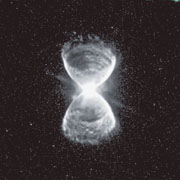Media
Back
Smoke rings from the puffs of a dying star
09 Jan 2007
| FOR RELEASE: Tuesday January 9, 2007 9.20 AM, Seattle Wednesday January 10, 2007 01.20 AM, Hong Kong Today at the meeting of the American Astronomical Society in Seattle, Washington, Prof. Sun Kwok, Dean of the Faculty of Science of The University of Hong Kong, and Chih Hao Hsia of the National Central University, Taiwan, announced their discovery of a series of rings in the dying star Hubble 12. These rings are apparently ejected by the star during the last ten thousand years of its life, practically the very last breath of its billion-year long life. Hubble 12, a seemingly unremarkable nebula of stellar appearance, was first discovered by Edwin Hubble in 1921. Pictures obtained with the Hubble Space Telescope (HST) show that it in fact has a perfect hourglass shape with a tight waist. By performing a detailed analysis of the HST images, Kwok and Hsia found a series of nine rings along the axis of this hourglass-shape nebula. These mysterious rings are circular in shape and lined up precisely one after another. Why a star in the last stretch of its life would generate such perfectly shaped rings is a mystery. Most stars will become a planetary nebula near the end of their lives. Our Sun, will also undergo such a transformation in about five billion years from now. Astronomers have known for some time that planetary nebulae have a variety of shapes, but the details of the physical processes leading to such morphological transformation are not known. Prof. Sun Kwok, Chair Professor and Dean of Science at the University of Hong Kong, believes that the rings seen in Hubble 12 are related to the shaping of the nebula: "a series of fast, directional, periodic pulse ejections from the star carve out the remnants of previously ejected material and create the hourglass shape. The detection of these rings will help us understand the last metamorphosis of stars." The Hubble Space Telescope, with its superior imaging capability, has taken many beautiful pictures of planetary nebulae, showing their rich colors and remarkable shapes. These pictures, including the images of Hubble 12 shown here, have generated great excitements among astronomers and motivate their quest to find out "how stars die". It is fitting that the HST, named after Edwin Hubble, should obtain a picture that would greatly enhances our understanding of the nebula that Hubble himself discovered 85 years ago. Prof. Sun Kwok is an expert in the study of planetary nebulae best known for his theory postulated in 1978 to explain the origin of these objects. He is the author of the books The Origin and Evolution of Planetary Nebulae (2000) and Cosmic Butterflies (2001) published by Cambridge University Press. He has also written a recent textbook Physics and Chemistry of the Interstellar Medium, published by University Science Books in October 2006. EDITORS: These illustrations can be obtained over the internet via http://sal.physics.hku.hk/~kwok/aas209 as soon as the embargo expires. For press enquiry and interview arrangement, please contact or Ms Cindy Chan of the Faculty of Science of The University of Hong Kong at 2241 5286. Remarks: The press release is released by American Astronomical Society in Seattle through The University of Hong Kong. Picture captions Picture 1: A Hubble Space Telescope picture of the planetary nebula Hubble 12 in the constellation of Cassiopeia. A series of rings on both sides of the hourglass can be seen Picture 2: A schematic sketch outlining the rings. The solid parts of the ring are at the front and the dotted parts of the ring are in the back. The bottom half of the hourglass is tilted towards us. |
 Picture 1  Picture 2 |
